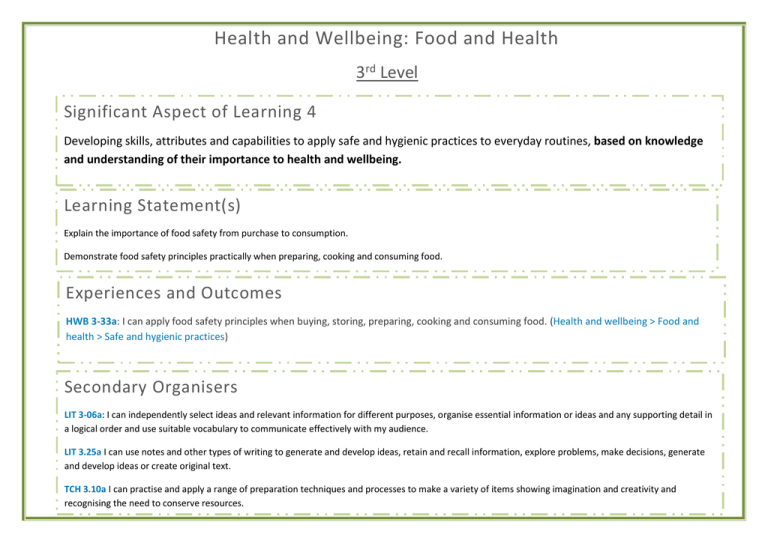Health and Wellbeing: Food and Health Significant Aspect of Learning 4 3
advertisement

Health and Wellbeing: Food and Health 3rd Level Significant Aspect of Learning 4 Developing skills, attributes and capabilities to apply safe and hygienic practices to everyday routines, based on knowledge and understanding of their importance to health and wellbeing. Learning Statement(s) Explain the importance of food safety from purchase to consumption. Demonstrate food safety principles practically when preparing, cooking and consuming food. Experiences and Outcomes HWB 3-33a: I can apply food safety principles when buying, storing, preparing, cooking and consuming food. (Health and wellbeing > Food and health > Safe and hygienic practices) Secondary Organisers LIT 3-06a: I can independently select ideas and relevant information for different purposes, organise essential information or ideas and any supporting detail in a logical order and use suitable vocabulary to communicate effectively with my audience. LIT 3.25a I can use notes and other types of writing to generate and develop ideas, retain and recall information, explore problems, make decisions, generate and develop ideas or create original text. TCH 3.10a I can practise and apply a range of preparation techniques and processes to make a variety of items showing imagination and creativity and recognising the need to conserve resources. Lesson 1: Researching and Understanding… Learning Statement (s) Explain the importance of food safety from purchase to consumption. Learning Intention Through investigation and exploration, pupils will learn about the importance of good personal and kitchen hygiene to health and wellbeing. Knowledge & Understanding and Skills development: Peer discussions Reflecting upon personal learning through discussion Creating posters/leaflets to share learning with others Identifying importance of good hygiene Identifying and explaining rules in relation to buying, storing, cooking and eating food. Explain the importance of good personal and kitchen hygiene to health and wellbeing. Following initial discussions personal hygiene and why it is important when preparing food, pupils have to design a ‘clean’ chef. This would represent the basic personal hygiene rules which are enforced in the practical food room. Pupils then went in to look at the role temperature control played within the storage and cooking of food. Pupils then produced a ‘germometer’ in their workbooks to reflect this and identity key temperatures. Identifying and explaining rules in relation to buying, storing, cooking and eating food. At the end of this unit pupils had to create a leaflet which could be used for ‘Food Safety Week’. The leaflet was to contain all the key information pupils had learnt in relation to hygiene. These were displayed in classrooms. Success Criteria Pupils can identify and give a breadth of information on rules regarding buying, storing, cooking and eating food. Pupil Comments Pupil Comments “It is important you have good personal hygiene when handling food as you can make other people ill.” “The ‘germometer’ shows us the key temperatures for storing and cooking food. The danger zone is important as this is where bacteria will multiply.” “Bacteria like warm, moist places to grow and multiply so we have to remove this risk if we can.” “If a food business didn’t follow good hygiene rules, it would be closed down.” Next steps for learners: Disseminate knowledge to my peers and parents. Apply knowledge in practical food lessons Further explore links between hygiene and kitchen/food safety. Lesson 2: How to Apply my Learning in Practical Situations… Learning Statement(s) Demonstrate food safety principles practically when preparing, cooking and consuming food. Learning Intention Pupils will be able to demonstrate in a practical manner their knowledge of good personal and kitchen hygiene. Knowledge & Understanding and Skills development: Peer discussions Reflecting upon personal learning through discussion Creating kitchen rules. Identifying importance of good hygiene and applying this. PUPIL USING FOOD PROBE TO CHECK CORE TEMPERATURE. RULES WRITTEN BY PUPILS ARE DISPLAYED IN FOOD ROOMS Success Criteria Pupils can explain what hygiene standards need to be maintained in a practical food lesson. Pupils can apply personal hygiene rules in a practical food lesson and demonstrate good hygienic practices. Pupils can demonstrate temperature control when cooking with raw meat. Learner’s comment: Blue plasters must be used in the food room to cover any cuts as no food is naturally blue. Learner’s Comment: Learner’s Comment: It is important to wash your hands after touching raw meat and use different chopping boards to prevent cross contamination. When using a food probe the core temperature of the food should be at least 75oC. Next Steps in Learning as identified by the children: Interview chefs that work in commercial kitchens,. Create advice for other pupils to share learning (posters, labels, leaflets) that could be used within school’s health week. Continue to apply knowledge in all practical food lessons and when preparing and cooking food at home.





